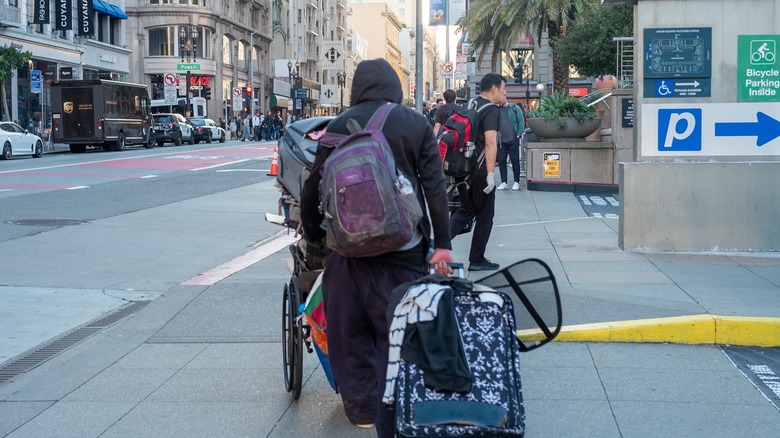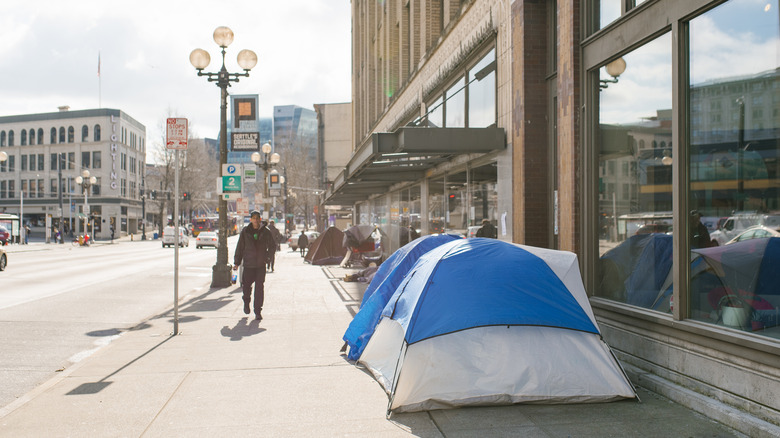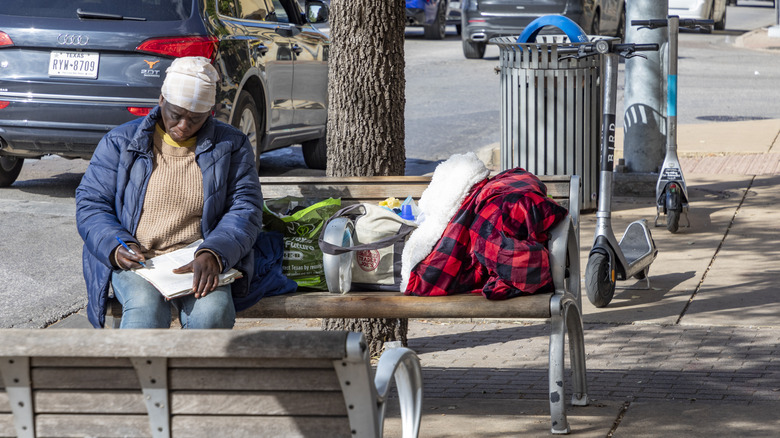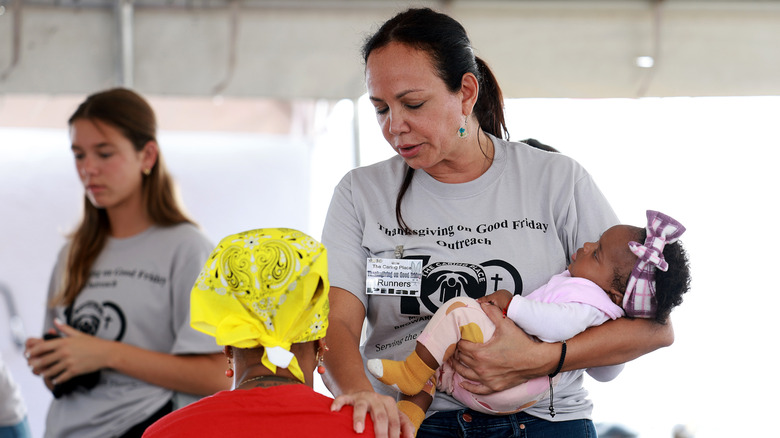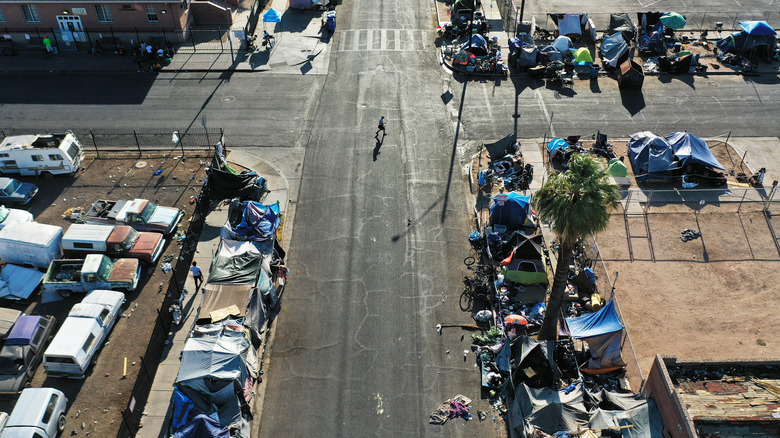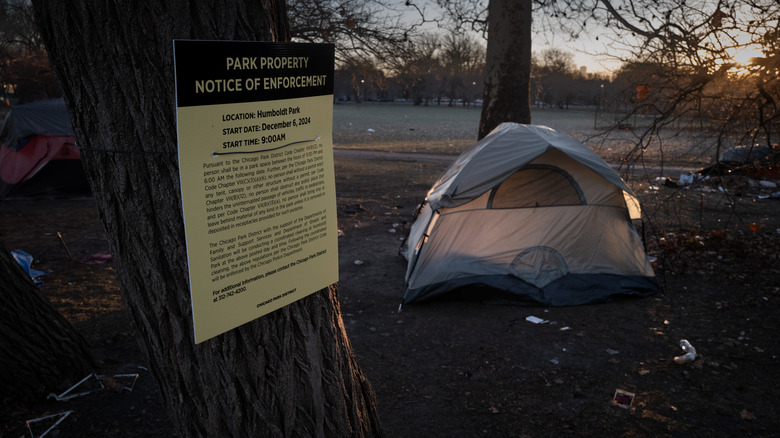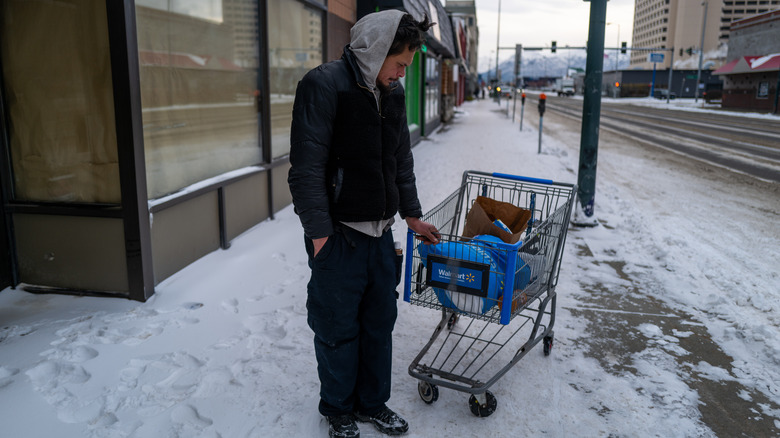These 12 States Have The Highest Homelessness Rates
There is no single cause for homelessness in the United States, though it is a bleak circumstance that touches every community within our country. Too often, the definition is reduced to simply living outside, often in a tent or occupying a space on the sidewalk. This is an inadequate understanding, ignoring the circumstances that force many Americans to sleep in their cars or on the couches of family members, a term known as "sofa-" or "couch-surfing."
Because of this murky understanding of what it means to be homelessness, it's hard to put forward an exact number for how many Americans are living unsheltered day to day. Some put the number between 770,000 and 3.5 million people based on one's understanding of the term; the number could reach over 7.4 million when factoring in those who combined shelter due to lost housing. With the rising cost of living and the difficulty many people face in finding or maintaining housing, this is an ongoing crisis with the potential to worsen.
While homelessness is both a reality and a concern nationwide, there are some states where citizens are experiencing greater housing difficulty than other places. These are the states that currently have the highest homelessness rats in America.
Hawaii
For many Americans, Hawaii represents a beautiful tropical paradise, a state that many aspire to move to and enjoy pleasant weather all year long. And yet, this is a place that is often cited as having the highest homeless rate across the entire country, impacting 805 people per 100,000 residents. According to a 2024 census project called the Point in Time (PIT) Counts, 6,389 people in Hawaii experienced homelessness; the respondents were both sheltered and unsheltered. Oahu, the most populated island of the state, had the largest representation of homelessness. That same report suggested the number of people who experienced homelessness in Oahu between 2023 and 2024 increased by 12%.
There are a couple of major issues at the heart of the high homelessness rate in Hawaii. First is the state's notoriously high cost of living. To live well, some estimate individual residents need an annual salary of no less than $70,000. Families are said to need at east $120,000, though in some areas of Hawaii, that number rises to $200,000. While Zillow reported that Hawaiian home values recently decreased by about 3%, the average cost of homes there is still $826,575.
Aside from the very high cost of living and housing, there is another, only recently explored side to Hawaii's homelessness crisis: the over representation of indigenous Hawaiians. Per the Civil Beat, nearly a third of homeless individuals in Oahu identified as Native Hawaiians. Considering their demographic, research suggests they are overrepresented among the island's homeless population by about 210%. By comparison, black and African American locals are overrepresented by 67%.
California
While Hawaii is known for having the highest rate of homelessness, California is associated with the highest overall number of people who are homeless. As of March 2025, it's estimated that more than 187,000 homeless individuals live in California, according to PPIC. This number includes 63,110 sheltered homeless and 123,974 unsheltered homeless people.
As for what's driving the record-breaking increase across this state, the root cause is quite startling in its simplicity. For many California residents, a sudden loss of income was enough to put them on a near-immediate path to homelessness. This was determined by a detailed study released by UC San Francisco. Even more harrowing, some admitted that having access to as little as $300 more could have been enough to keep them housed.
There is another, particularly controversial, potential reason behind why thousands of homeless people live in California is the act of busing this population to other places. Some cities will reportedly give homeless individuals one-way tickets to other states or towns, a practice confirmed by The Guardian to go back years. While California cities like San Francisco have programs like Homeward Bound to send homeless individuals out of the city, likewise, these people are more than likely bussed in from other towns, each trying to reduce their own homeless population. As to why so many would choose California as a destination, it's likely due to a combination of the warmer climate and the hope that state social programs can successfully alleviate their situations.
New York
The state of New York represents one of the most populous regions of the entire country; it boasts an overall population of nearly 20 million people According to state officials, the homelessness situation there has worsened significantly, with the number of people impacted increasing by 53.1% between 2023 and 2024. That same study found that the number of homeless children as of 2024 was 50,773, more than double the total reported in 2022. It's a problem that has worsened statewide, though with the greatest impact felt in New York City. It's said that at any given time, New York City alone shelters about 100,000 homeless individuals.
There are a few driving forces behind the ongoing homeless crisis in the region, including a substantially high cost of living paired with a notable lack of affordable housing. If you want to rent a studio apartment in New York City, the average monthly cost is reportedly around $3,264. While other areas of New York state are far cheaper to live, those drawn to this famous metropolis will apparently need close to $100,000 to survive. Meanwhile, a family of four will reportedly need over $318,000 per year to live comfortably. Failing to meet basic income requirements to match the local cost of living is one of the quickest ways to fall into a state of homelessness. The inability for some New Yorkers to meet high cost of living standards and find affordable housing is sometimes blamed on issues such as gentrification and the subsequent displacement of lower income households.
Oregon
According to some estimates, about 4.3 million people call Oregon home, and though the population growth rate has slowed significantly in recent years, this has done little to abate the ongoing homelessness crisis within the state. As of 2024, it's believed that Oregon has at least 22,000 homeless individuals residing within the state. The highest concentration is thought to be in Multnomah County; data from Oregon Live shows the area has a homeless population that exceeds 14,000. Statewide, the situation is severe enough that Oregon alone reportedly accounts for roughly 2.6% of America's homeless men, women, and children.
A range of demographics are vulnerable to homelessness, including veterans, teens that age out of foster care, individuals suffering from mental illness, and those struggling with addiction. In addition to poor mental health and addiction, other direct causes for homelessness in Oregon include high housing costs and a lack of economic stability. There are areas of the state that are more affordable, however a family of four would need at least $117,000 to thrive in Portland. A loss of reliable income could cause an individual or family to very quickly lose their home and way of life here. The Oregon Community Foundation also warns of "an inadequate housing supply and rising rent" which could leave "tens of thousands of Oregon children and families at risk of becoming homeless."
Washington
As with west coasts states California and Oregon, Washington is another state with a very large homeless population. There's been a notable increase in homelessness, with Washington officials estimating that 22,173 homeless individuals reside here as of early 2025. The data showed 67% of those accounted for are sheltered, which meant they lived in transitional housing or emergency shelters. The remaining 33% are completely unhoused. It's worth noting that this data does not include information for unsheltered individuals in King County, where Seattle is located. In 2024, research put forward by the King County Regional Homelessness Authority (KCRHA) claimed the county's homeless population was 16,868. Worryingly, this total is reportedly a 26% increase from the 2022 estimate.
The statewide homelessness issue is one that has been a major concern for years, with much of the blame put on increasing housing and rent costs, with wages not rising to meet them. There was some good news recently, with The Seattle Times reporting that Washington was experiencing a slowing down of reported homelessness. That said, some were worried that nearing federal and state budget cuts to programs meant that things could revert, and the state would once again face a sharp spike in homeless locals.
Texas
That Texas is a state experiencing severe homelessness may be a startling revelation to many Americans because certain towns here are said to be among the most affordable places to live. Unfortunately, while it is true that locations like Brownsville or Wichita Falls are cited as highly affordable, this fact is not enough to undo the reality of homelessness within the state. Major cities like Houston, Dallas, San Antonio, and Austin account for thousands of homeless individuals. As recently as 2023, the Texas Homeless Network noted there were 27,377 cases of homelessness in Texas.
There are some surprising and unfortunate causes contributing to the Texas homeless crisis. While some sources blamed a lack of affordable housing and rising costs, there are others who point to "systematic factors," such as generational poverty, racism, and even the state criminal justice system. There is also criticism for the state government's approach to homeless individuals, which includes arrests, forceable removals, and deliberate encampment destruction. Governor Greg Abbott's justification for the state's sweep of homeless camps and the removal of homeless people is to make the area "safer and cleaner," according to the Texas Tribune. His approach has put him at odds with other government officials. For instance, Austin Mayor Kirk Watson finds the removals to be costly, while not providing alternative places for the forcibly removed individuals to go.
Florida
According to the Florida Coalition to End Homelessness, on any given night, there are approximately 28,498 homeless individuals in the state. Of that total, it's believed about 20% are chronically homeless, which means they have either been without housing multiple times or for prolonged periods. About 30% of this group are either coping with mental health or substance abuse issues. There are contributing factors here that you'll find elsewhere, such as rising costs and housing scarcity. Yet there is an issue unique to this part of the country that could pose a severe risk of becoming unhoused.
In 2022 alone, Invisible People found that 10,000 Floridians became homeless in the aftermath of Hurricane Ian. Each year, extreme weather conditions leave hundreds to thousands of people without homes. While some people have the resources to rebuild their home locally or relocate to a different part of the country, many people do not, especially if they lack savings or live in low-income households. Even if people previously thought they were covered, the ongoing Florida home insurance crisis could mean they do not have the protection they assumed they did, and they're instead vulnerable to immediate and potentially permanent homelessness. The situation in Florida is made all the more severe by a readily enforced anti-encampment law passed by Governor Ron DeSantis.
Massachusetts
Per U.S. News & World Report, Massachusetts is ranked the richest state in the country. Here, the median income is a little over $100,000. But while Massachusetts is considered by some to be among the wealthier states, that does not mean that the locals enjoy equal access to a high standard of living or stable housing. In fact, Massachusetts has a high percentage of homelessness relative to many other U.S. states. The Telegram & Gazette reported 29,435 homeless individuals counted across the state. This number reportedly represents a 54% surge, with 19,107 counted in 2023. During that same period, the state noted an increase in chronic homelessness, including hundreds of chronically homeless families.
Aside from unaffordable housing and rising costs, one of the main reasons for the increase in recent years is the domino effect caused by the COVID-19 pandemic. Despite state moratoriums on evictions, there was a notable increase in the years following the pandemic era. The Telegram also mentioned "an influx of migrants into Massachusetts," who were believed to have contributed to the homeless total.
Being homeless in a state like Massachusetts can be especially risky at times, as the frigid winter weather can make living here without adequate shelter very dangerous.
Arizona
The Arizona Department of Economic Security released a report in 2024 that painted a stark picture of the state's homelessness situation. Released research included the 2024 Arizona PIT Count, which identified about 14,737 individuals as homeless in January 2024, a 3% increase from the 2023 snapshot. Despite the overall rise in statewide homelessness, there was an estimated 4% decrease in Arizona's unsheltered homeless population, dropping from 7,615 people to 7,291.
While these numbers concern Arizona as a whole, a large portion of impacted individuals can be found in Maricopa County, whose largest city is Phoenix. In fact, there is an area of Phoenix, known as the Zone, a homeless encampment where an estimated 800 people live in tents and other forms of makeshift housing. There is a lot of controversy surrounding this section of the city, with a lawsuit filed by Phoenix citizens and some going as far to claim the encampments existence violates state environmental laws. And yet, its destruction does not offer an immediate resolution as to the fates of the hundreds of individuals and families who would be thrust onto the streets, completely unsheltered. This was the case with previous attempts to clear the area, and it only resulted in a slow return to the Zone, as the impacted homeless had nowhere else to go.
Illinois
In Illinois, homelessness among its population has been an issue going back to the 1980s. Significant steps were taken to cope with the issue. For instance, in 1993, House Bill 267 was signed into law. This legislation was designed to provide "state-funded supportive services for low-income families and individuals who are formerly homeless or at risk of becoming homeless." Initial funding was $200,000. Despite the efforts of the Illinois state government, homelessness remained a steady concern throughout the years. Some contributing factors to the crisis include high unemployment rates, significant poverty, poor wages, health problems, and the need to flee from domestic abuse.
The situation is dire statewide, with the number of homeless persons in the area estimated to be around 25,000. Many of these people are in Chicago, where approximately 18,836 people experienced homelessness at some point in 2024, according to the organization Chicago Homeless. This represents a substantial surge from 6,139 people counted in 2023. In addition to ongoing issues, it's believed that a dramatic increase in migrants seeking asylum is a major cause of the notable spike. Some local governments have responded to the rise in area homeless populations with harsh measures, including forcibly removing these individuals and families from the area. However, Illinois's state officials warn that the efforts taken could in fact violate the rights of the unhoused.
Colorado
The homeless situation in Colorado might be more severe than many Americans know. According to 2024 PIT data, a snapshot had 14,439 people experiencing homeless on any given night of the year. However, a Colorado Homeless Management Information System study showed that across 2024 more than 52,000 people required state homeless services. According to the study, about 6% of homeless Coloradans are veterans, while 30% of those counted deal with chronic homelessness. Likewise, the racial breakdown saw native Hawaiian/Pacific Islander, black/African Americans, and native/indigenous Americans three to fourteen times more likely to be homeless compared to the general Colorado population. It's believed that about 10,000 of the area's homeless population is concentrated in the Denver metropolitan area.
The past several years have shown a sharp climb in Colorado's homeless population. The Regional Economic Development Institute put the causes down to a variety of factors, including "poverty, unemployment, and a lack of affordable housing," while also mentioning a "widening gap between wages and housing costs in many urban areas" of the state. The institute also noted that a lack of resources for healthcare put those with severe mental health and substance abuse issues at risk for homelessness. Colorado organizations are working to keep up with the issue. In 2023, there were 358,435 emergency shelter beds and 88,626 beds through transitional housing programs available.
Alaska
Despite being the largest U.S. state in terms of sheer landmass, Alaska actually has one of the smallest populations. As of 2025, the state's total population is a little more than 741,000. According to the Anchorage Daily News, about 2,686 people in Alaska experienced homelessness in 2024. While that number might seem small, it represents a disturbingly high rate relative to the state's total population. The ADN also noted the state had seen homelessness climb by 40.8% since 2019. It's believed that of Alaska's total homeless population, nearly half can be accounted for in the Anchorage region alone. Large encampments are reportedly set up in more populated areas during the summer months, which make for unique and difficult challenges during Alaska's harsh winter season.
Following the COVID-19 pandemic, Anchorage responded to the ongoing homeless issue by pouring funds into outreach programs and mass opening shelters across the area. Though efforts led to an initial ease of homelessness, in recent years, things seem to have gotten worse. One major source of concern is that despite the best efforts to account for and accurately estimate the homeless individuals in the state, there is an "invisible" population to consider. Namely, those who are "couch surfing" or who have doubled or even tripled into a smaller living space to avoid being unsheltered, especially during colder months.


